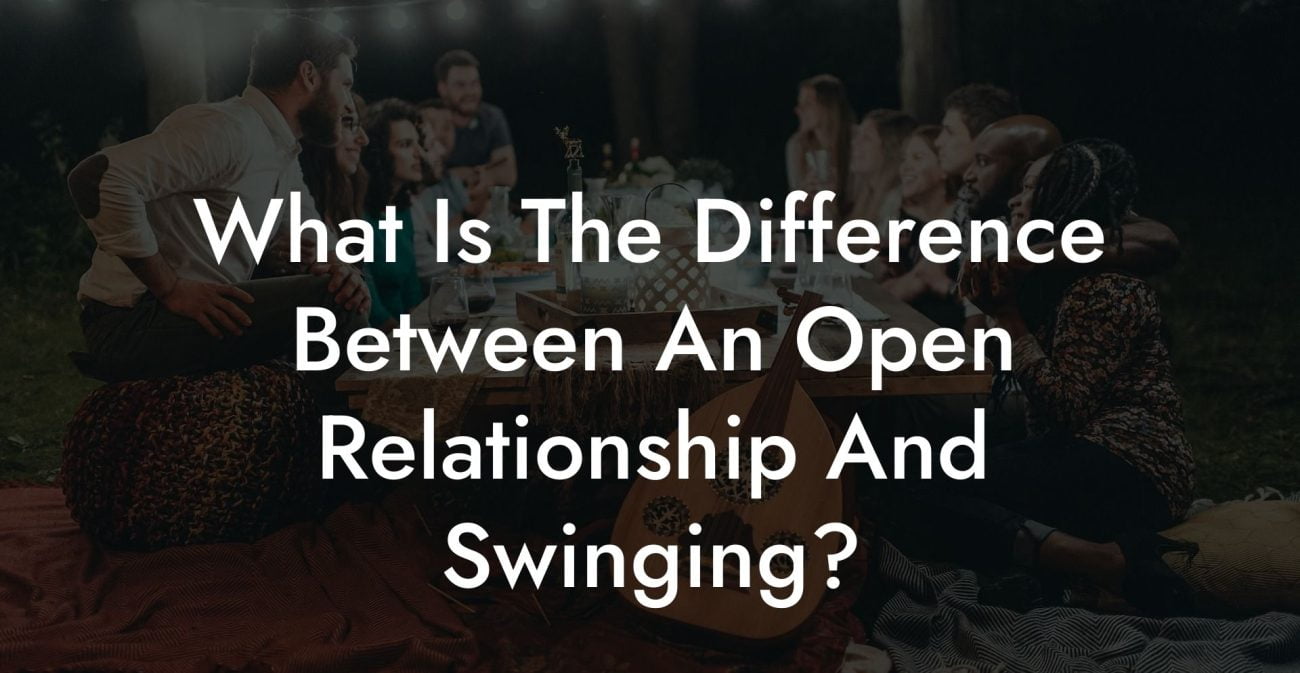Soft Swinging

Imagine a laid-back party where the energy is playful and the atmosphere is warm—an environment where intimacy is celebrated in its softest, most unhurried form. Welcome to the world of Soft Swinging, a lifestyle choice that prioritizes light, casual sexual encounters and gentle exchanges of intimacy, often with a focus on connection and fun rather than intense, all-out sexual experiences. This guide will take you on a deep dive into soft swinging—exploring its definition, its place within the spectrum of swinging, the benefits and challenges it presents, and practical strategies for navigating this liberating lifestyle with clear communication, mutual trust, and a sense of adventure.
Have you ever wondered if monogamy is just a stupid little experiment? Open relationships, polyamory, relationship anarchy...find out which relationship dynamic suits you best with our one minute relationship test. See if you are just conforming to "societal norms". Reveal your truth >>
Quick Links to Useful Sections
- Understanding Soft Swinging
- What Is Soft Swinging?
- The Spectrum of Swinging: Soft vs. Full Swap
- Understanding the Differences
- Historical and Cultural Context
- Evolution of Swinging Practices
- Philosophical Underpinnings and Core Values
- The Spirit of Playful Exploration
- Consent, Communication, and Mutual Respect
- Benefits of Soft Swinging
- Diverse and Low-Pressure Experiences
- Enhanced Communication and Trust
- Opportunities for Personal Growth
- Maintaining Balance and Connection
- Challenges of Soft Swinging
- Managing Ambiguity in Expectations
- Handling Jealousy and Emotional Insecurity
- Time and Energy Coordination
- Social Stigma and Misconceptions
- Strategies for Successful Soft Swinging
- Establish Clear Communication
- Set and Revisit Boundaries
- Leverage Digital Tools for Coordination
- Prioritize Self-Care
- Build a Supportive Community
- Embrace Flexibility and Enjoy the Journey
- Real-Life Success Stories
- Case Study: Jamie’s Exploration of Soft Swinging
- Case Study: Riley and Sam’s Balanced Approach
- Expert Insights on Soft Swinging
- FAQ: Your Soft Swinging Questions Answered
Understanding Soft Swinging
What Is Soft Swinging?
Soft swinging is a form of ethical non-monogamy that involves engaging in casual sexual or romantic encounters with other couples or individuals in a way that is less intense and more relaxed than full swap or hardcore swinging. In soft swinging, the focus is on playful intimacy and connection without the expectation of deep, long-term commitment or all-out partner swapping. The encounters are often characterized by a “softer” approach—meaning that they might involve light kissing, fondling, or other non-penetrative activities, and sometimes one partner may engage while the other prefers to remain in a more observational or supportive role.
Unlike full swap swinging, where both partners of a couple exchange partners completely, soft swinging can be more flexible. It can be practiced by couples who wish to explore erotic experiences together without the pressure of a complete exchange, or by individuals who prefer a lower-pressure, more casual form of sexual exploration. The emphasis is on mutual consent, open communication, and the enjoyment of playful, low-key encounters that allow participants to explore their desires without heavy expectations.
The Spectrum of Swinging: Soft vs. Full Swap
Understanding the Differences
Swinging, as a lifestyle, spans a spectrum—from full swap swinging, which involves a complete exchange of partners between couples, to soft swinging, where the encounters are more limited or less physically intense. Full swap swinging might include sexual activities that are explicit and involve all parties simultaneously, while soft swinging is more about flirtation, gentle physical intimacy, or even a scenario where one partner engages in an encounter while the other remains more in a spectator or supportive role.
In soft swinging, the stakes are often lower, and the emotional investment might be less intense. The focus is on enjoyment and exploration rather than deep sexual passion or competition. This approach can be especially appealing to couples who are new to the swinging scene or those who prefer a more relaxed, less challenging experience.
Historical and Cultural Context
Evolution of Swinging Practices
The swinging lifestyle has evolved significantly over the decades. While partner swapping and non-monogamous arrangements have historical roots in various cultures, modern swinging emerged as a distinct subculture during the sexual revolution of the 1960s and 1970s. Soft swinging, in particular, developed as a way for couples to explore their sexuality and break free from the confines of strict monogamy without feeling forced into extreme or highly competitive encounters.
Over time, as the swinging community grew and diversified, soft swinging became a popular option for those who wanted to experiment with non-monogamy in a more gentle and accessible way. Today, soft swinging is embraced by individuals and couples who seek adventure, variety, and fun, all while maintaining a comfortable, low-pressure atmosphere.
Philosophical Underpinnings and Core Values
The Spirit of Playful Exploration
At its heart, soft swinging is about playful exploration and self-expression. It’s a lifestyle that encourages you to step outside of conventional norms and experiment with different forms of intimacy without the pressure of a full commitment. The focus is on enjoying the moment, being present, and discovering new facets of your sexuality in a respectful and consensual environment.
This philosophy is rooted in the belief that sexual expression can be fluid and that intimate connections do not always have to carry the weight of long-term commitment. It’s about savoring the experience of connection—whether fleeting or recurring—and embracing the idea that pleasure can take many forms.
Consent, Communication, and Mutual Respect
As with all forms of ethical non-monogamy, the pillars of soft swinging are consent, open communication, and mutual respect. Consent must be clear and enthusiastic from all parties involved, and it’s essential that everyone is on the same page regarding expectations and boundaries. Transparent communication helps prevent misunderstandings and ensures that the experience remains enjoyable and safe for everyone.
In soft swinging, these principles create an environment where even casual encounters are treated with care and dignity, making sure that no one feels pressured or undervalued.
Benefits of Soft Swinging
Diverse and Low-Pressure Experiences
One of the key benefits of soft swinging is the opportunity to experience a wide range of sexual and emotional encounters without the high stakes of full partner swapping. It allows couples to explore new forms of intimacy and erotic expression in a more relaxed setting, which can be particularly appealing for those new to swinging or those who prefer a gentler approach.
This low-pressure environment encourages experimentation and self-discovery, allowing you to learn about your desires, boundaries, and what truly brings you pleasure.
Enhanced Communication and Trust
Engaging in soft swinging requires open dialogue and regular check-ins, which can improve communication skills and build trust between partners. When couples discuss their expectations, set clear boundaries, and share their experiences, they not only enhance their swinging encounters but also strengthen their primary relationship.
Opportunities for Personal Growth
Soft swinging provides a platform for self-exploration and personal growth. The casual, exploratory nature of these encounters can lead to a better understanding of your sexuality and emotional needs. It also allows you to see different aspects of yourself and your partner, fostering growth both individually and as a couple.
Maintaining Balance and Connection
For couples who value their primary relationship but also desire additional experiences, soft swinging offers the perfect balance. It allows you to keep your core connection strong while still enjoying the excitement and variety that comes from exploring new sexual or romantic interactions.
Challenges of Soft Swinging
Managing Ambiguity in Expectations
The casual nature of soft swinging can sometimes lead to ambiguity regarding expectations. Without clear definitions of what constitutes a casual encounter versus something more, misunderstandings can occur. It’s essential to have upfront conversations about what each party wants and to revisit those discussions as needed.
Handling Jealousy and Emotional Insecurity
Even in a low-pressure environment, feelings of jealousy or insecurity may arise. Seeing your partner with someone else—even in a casual context—can trigger emotions that need to be managed with honest dialogue and self-reflection. Addressing these feelings promptly is key to maintaining emotional balance.
Time and Energy Coordination
Balancing multiple casual encounters alongside your everyday life can be challenging. It requires careful time management and an awareness of your own limits. Without effective coordination, you risk overcommitting, which can lead to burnout or neglect of your primary relationship.
Social Stigma and Misconceptions
Despite growing acceptance, casual swinging can still be misunderstood by those who adhere to traditional relationship norms. Social stigma and external judgment may affect your self-esteem and lead to feelings of isolation. Building a supportive network of like-minded individuals is crucial to overcome these challenges.
Strategies for Successful Soft Swinging
Establish Clear Communication
The foundation of successful soft swinging is clear, honest communication. Have explicit conversations with your partner(s) about what you want from your casual encounters. Define what “casual” means for you, set clear boundaries, and agree on how much information you will share about other encounters.
Regular check-ins before, during, and after events can help ensure that everyone’s on the same page and that any concerns are addressed promptly.
Set and Revisit Boundaries
Clearly define your limits regarding emotional involvement, physical intimacy, and time commitment. Document these boundaries using digital tools like shared notes or calendars so that they can be easily referenced and adjusted as needed.
Being flexible and willing to renegotiate boundaries is key to adapting to changes in your desires or circumstances.
Leverage Digital Tools for Coordination
Utilize digital calendars, scheduling apps, and group messaging platforms to coordinate your swinging activities. These tools can help you manage your time effectively, ensuring that you have enough space for your primary relationship as well as your casual encounters.
Prioritize Self-Care
Make self-care a non-negotiable part of your routine. Engage in activities that nurture your physical, mental, and emotional well-being, such as exercise, meditation, or creative hobbies. Regular self-reflection through journaling or therapy can help you process any emotions that arise and maintain a healthy sense of balance.
Build a Supportive Community
Connect with others who share your lifestyle by joining online forums, social media groups, or local meet-ups dedicated to swinging and ethical non-monogamy. A supportive community provides valuable advice, emotional support, and a safe space to discuss challenges and celebrate successes.
Embrace Flexibility and Enjoy the Journey
Understand that soft swinging is inherently fluid and may evolve over time. Embrace the spontaneity and enjoy each experience for what it is, without putting undue pressure on any single encounter. A flexible mindset allows you to adapt as your desires and boundaries shift.
Real-Life Success Stories
Case Study: Jamie’s Exploration of Soft Swinging
Jamie, a couple’s enthusiast new to the swinging scene, found that soft swinging offered the perfect balance of excitement and emotional safety. By engaging in casual, low-key encounters and maintaining open communication with their partner, Jamie was able to explore new dimensions of intimacy without compromising their primary bond. Regular check-ins and clear boundaries helped Jamie manage any emerging insecurities, ultimately leading to a fulfilling and enriching experience.
Case Study: Riley and Sam’s Balanced Approach
Riley and Sam decided to experiment with soft swinging as a way to add variety to their long-term relationship. They established clear rules about what activities would remain casual and agreed to keep certain encounters strictly non-sexual. Their commitment to transparency and regular dialogue allowed them to navigate potential jealousy and ensure that both felt respected and valued. Their experience demonstrates that soft swinging can be successfully integrated into a committed relationship, enriching both partners’ lives.
Expert Insights on Soft Swinging
Relationship experts emphasize that soft swinging, when practiced with clear communication and mutual consent, can be an empowering way to explore sexual and emotional boundaries. Dr. Elena Rivera, a therapist specializing in ethical non-monogamy, states, “Soft swinging allows couples to experience sexual exploration in a way that’s respectful and low-pressure. It’s all about understanding and negotiating boundaries so that everyone can enjoy the experience safely.”
Relationship coach Marcus Lee adds, “The key to soft swinging is maintaining open channels of communication and being clear about what you expect. When all parties are on the same page, the experience can be both liberating and deeply satisfying.”
FAQ: Your Soft Swinging Questions Answered
1. What is soft swinging?
Soft swinging is a form of swinging where couples engage in casual, often non-penetrative, sexual or romantic encounters with other couples or individuals, with a focus on light, playful intimacy rather than full, intense partner swapping.
2. How does soft swinging differ from full swap swinging?
In soft swinging, the encounters are generally less intense and may involve one partner engaging in light intimacy while the other remains more in a supportive or observational role. Full swap swinging, by contrast, involves a complete exchange of partners for a more intense sexual experience.
3. What are the key benefits of soft swinging?
Benefits include the opportunity to explore new forms of intimacy, reduced emotional pressure, enhanced communication, and the freedom to enjoy varied experiences while maintaining your primary relationship.
4. What challenges might I face in soft swinging?
Challenges can include managing ambiguous expectations, potential jealousy or insecurity, and balancing time between your primary relationship and casual encounters.
5. How important is communication in soft swinging?
Communication is critical; clear, honest dialogue about boundaries, expectations, and feelings is essential for ensuring that all participants feel safe and respected.
6. How can I set boundaries in a soft swinging arrangement?
Clearly define what is acceptable in terms of physical intimacy, emotional involvement, and time commitment. Regularly revisit these boundaries with your partner(s) to ensure they remain relevant.
7. What role do digital tools play in soft swinging?
Digital tools like shared calendars, messaging apps, and digital journals help coordinate schedules and maintain consistent communication, ensuring that each encounter is well-managed.
8. How can I manage jealousy in soft swinging?
Address jealousy through open dialogue, use “I” statements to express your feelings, and engage in regular self-reflection or therapy if needed.
9. Can soft swinging eventually lead to deeper relationships?
While soft swinging is generally intended as a casual exploration, some encounters may evolve into deeper connections if both parties desire it. However, the primary goal is to enjoy light, non-pressured intimacy.
10. Where can I find more resources on soft swinging?
Resources include books like "The Ethical Slut" and "More Than Two", podcasts such as “Multiamory,” and online communities on Reddit and Facebook dedicated to swinging and ethical non-monogamy.
Resources and Community Support: Your Next Steps in Exploring Soft Swinging
- Books: Start with foundational texts like "The Ethical Slut" and "More Than Two" for insights into ethical non-monogamy and casual swinging dynamics.
- Podcasts: Listen to shows such as "Multiamory" to hear real-life stories and expert advice on managing casual encounters.
- Online Communities: Engage with swinging and polyamory forums on Reddit and Facebook groups to share experiences and gather advice.
- Workshops and Webinars: Attend events focused on communication, boundary-setting, and relationship management to enhance your soft swinging experience.
- Therapy and Counseling: Consider professional support from therapists who specialize in ethical non-monogamy for personalized guidance.
Soft swinging offers a liberating, playful approach to exploring intimacy and connection without the pressure of heavy commitment. With clear communication, flexible boundaries, and supportive community resources, you can embrace this lifestyle as a fun and enriching part of your romantic journey.
Lost & confused by all of the terms, types and seemingly made up 3 letter acronyms?? We've got you. Check out our Ethnical Non-Monogamy Dictionary >>
Useful Interruption: Not sure which relationship vibe fits you best? Take our Relationship Test, it’ll give you the real insight into your natural relationship style. Then, dive into our binge-worthy guides (from the tried-and-true to the “wait, that’s a thing?”) and find the perfect relationship type for your life:
- Monogamy
- Open Relationships
- Ethical Non-Monogamy
- Solo Polyamory
- Non-Hierarchical Polyamory
- Hierarchical Polyamory
- Relationship Anarchy
- Swinging
Now back to the main article but yeah take the test...








